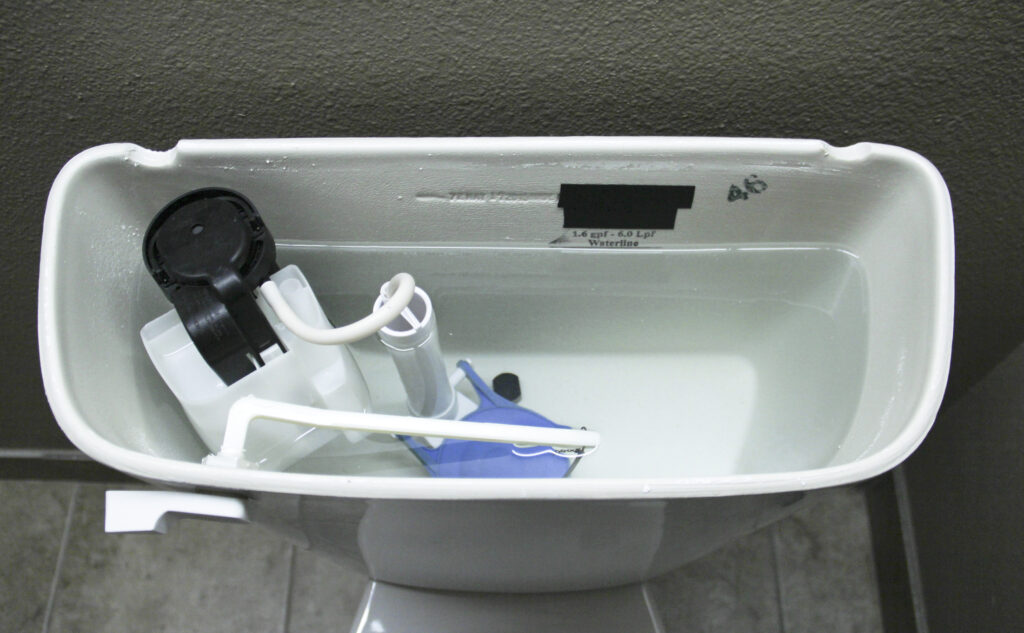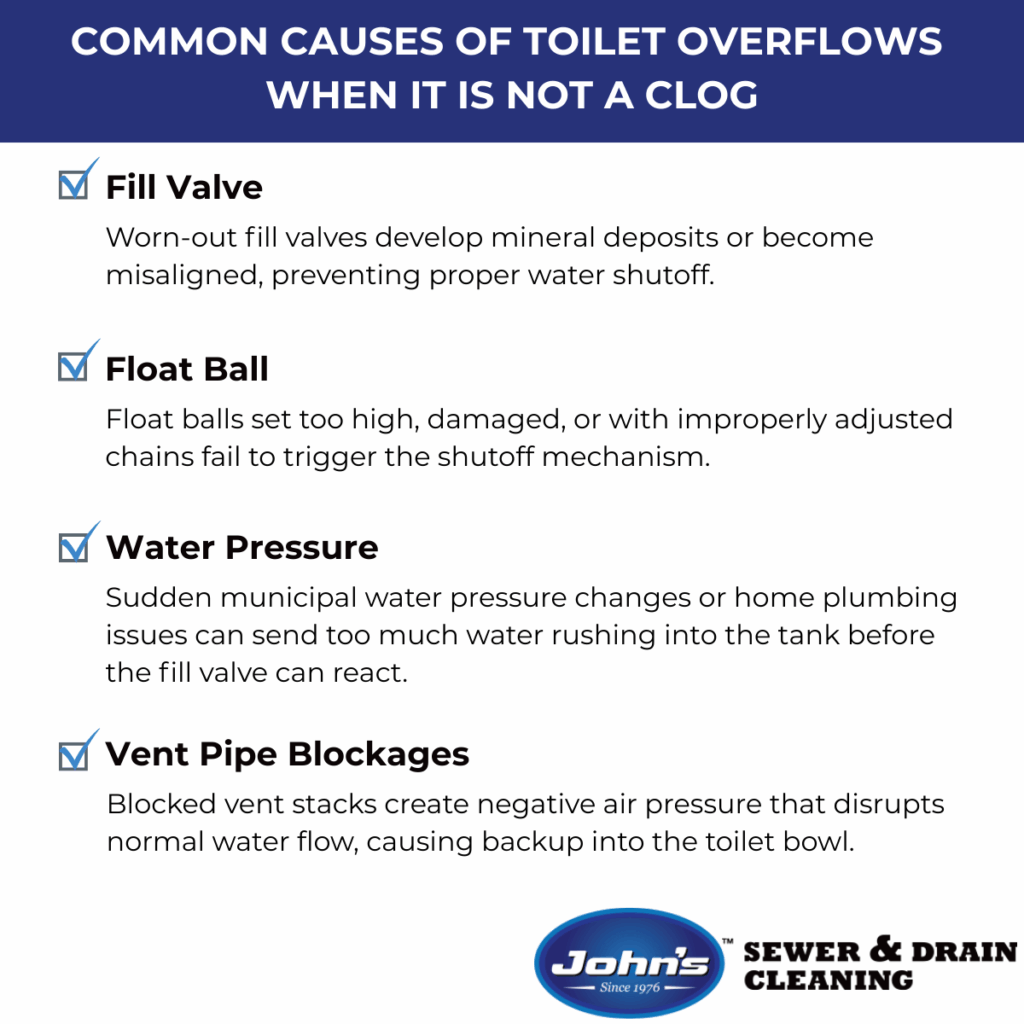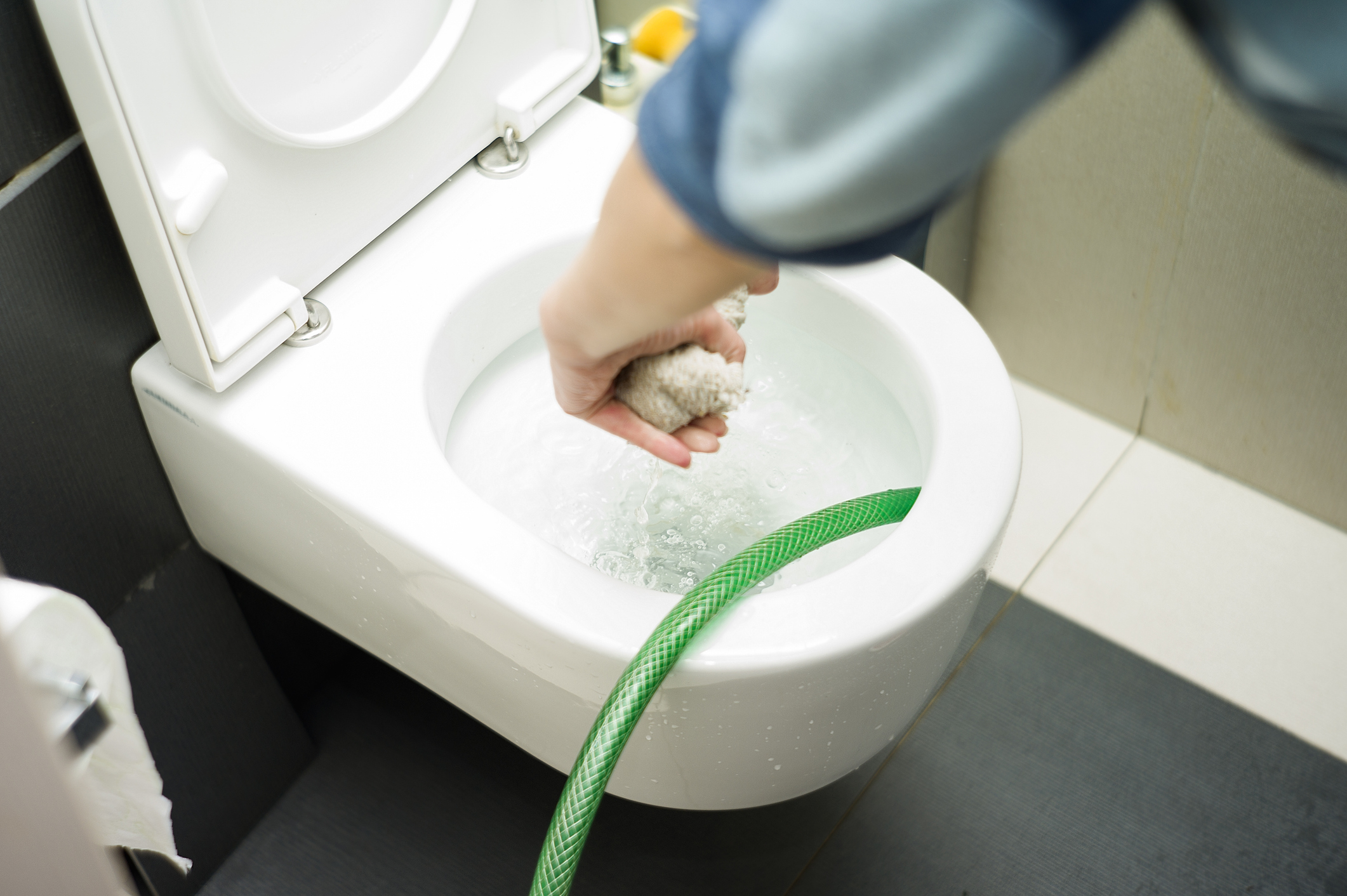The Short Answer: A toilet that’s overflowing without being clogged typically indicates an issue with the fill valve or toilet tank components. This usually happens when the float ball malfunctions or the water level isn’t properly regulated by the tank mechanisms.
When your toilet bowl keeps filling with water despite having no visible toilet clog, it can be both puzzling and concerning. Water continuously rising above normal levels creates a real risk of flooding and water damage to your bathroom floor. The problem often stems from internal tank mechanisms that control water flow, and while it might seem minor at first, it can lead to significant wastewater issues and higher utility bills.
In this guide, we’ll walk you through the main reasons your toilet might overflow without a clog, show you how to identify the specific cause, and provide clear solutions you can try at home. We’ll also cover when it’s time to call a professional plumber and share maintenance tips to prevent future toilet overflow issues. Whether you’re dealing with this problem right now or want to be prepared, you’ll find advice to address the issue here.
Understanding Your Toilet’s Tank Mechanics

The inner workings of your toilet tank might seem complex, but knowing these basic parts can help you spot and fix toilet overflow issues before they become major plumbing problems. The tank houses three main components that control water flow: the fill valve, float ball, and flush valve.
- The fill valve, located on the left side of your toilet tank, controls water flowing into the tank after each flush. Think of it as a water faucet that automatically turns on when the tank needs refilling. This valve connects to your home’s water supply through a metal or plastic pipe at the tank’s base.
- The float ball works like a swimming pool float, rising and falling with the water level. When you flush, the float drops as water leaves the tank. As fresh water flows in, the float gradually rises until it reaches the correct height, typically about an inch below the top of the overflow tube. At this point, it signals the fill valve to stop the water flow.
- The float cup fulfills the same purpose as a float ball but with a different design. This cylindrical device slides up and down along the fill valve shaft rather than floating freely in the tank. As water rises, the float cup moves upward until it reaches a preset height, triggering the fill valve to shut off. Most modern toilets use float cups instead of float balls because they provide more reliable water level control and are less prone to misalignment.
- Your flush valve sits in the center of the tank, controlling water release into the toilet bowl when you press the handle. The flush valve includes a rubber flapper that lifts when you flush, allowing water to rush into the bowl. When the tank empties, the flapper drops back down, creating a seal so the tank can refill.
A properly working tank maintains water about one inch below the top of the overflow tube. You’ll know something’s wrong if you hear constant running sounds, see water flowing into the overflow tube, or notice the tank filling above this level. These signs often point to worn-out parts that need adjustment or replacement.
Common Causes of Non-Clog Overflows
A toilet can overflow even when there’s no visible clog due to several issues with the toilet tank’s internal mechanisms.
- The fill valve assembly, which controls water flow into the toilet tank, often causes these problems.
- When this fill valve wears out over time, mineral deposits can build up inside it, preventing proper water shutoff.
- The valve can also become misaligned during cleaning or maintenance, causing it to stay partially open.
- The float ball tells the fill valve when to stop adding water to the tank.
- If the float ball is set too high, water will continue flowing until it spills through the overflow tube and into the toilet bowl.
- A bent or damaged float ball might not properly trigger the shutoff mechanism.
- A tangled, too-short chain, or a chain with too much slack connecting the flush valve to the rubber flapper can prevent the tank from sealing correctly after flushing.
- Water pressure issues round out the main causes of non-clog overflows.
- Sometimes the problem starts at the municipal level, where sudden pressure changes in the main water supply can affect how your toilet fills. Inside your home, problems with pressure-reducing valves or other plumbing issues can send too much water rushing into the toilet tank. When this happens, the fill valve might not react quickly enough to prevent overflow, even though the toilet isn’t clogged at all. This is a less common cause compared to component failures.
- Vent pipe blockages can also contribute to backup or drainage issues.
- Your home’s plumbing vent stack extends from your pipes through the roof, allowing air to enter the system and equalize pressure. When this vent becomes blocked by leaves, debris, or even bird nests, it creates negative air pressure in the pipes. This vacuum effect can disrupt normal water flow, causing water to back up into the toilet bowl instead of draining properly. Signs of a blocked vent include gurgling sounds when flushing, slow drains throughout your home, and sometimes sewer odors.

DIY Troubleshooting Steps
Before diving into any toilet repairs, always start by turning off the water flow. Look for the oval-shaped knob behind your toilet near the wall and turn it clockwise until it stops. This simple step prevents any additional water from entering the toilet bowl while you work.
Basic Tools You’ll Need
These items will handle the most basic toilet overflow fixes
- An adjustable wrench
- A few old towels
- A pair of rubber gloves
Having a small bucket nearby is also helpful to catch any water spills during your inspection.
Checking the Fill Valve
The fill valve, located in the toilet tank, controls water flow into your toilet. Remove the tank lid and watch the filling process after a flush. If you notice water continuously running into the overflow tube, your fill valve likely needs adjustment. Look for cracks, mineral buildup, or debris that might prevent proper operation.
Float Mechanism Fixes
Your toilet’s ball float controls the water level in the tank. If it’s set too high, water will constantly flow into the overflow tube. For ball-style floats, gently bend the arm downward slightly. For cylinder floats, look for an adjustment clip or screw on the side of the fill valve assembly. The water level should rest about one inch below the top of the overflow tube.
Clearing Vent Pipe Blockages
If you suspect a blocked vent pipe is causing your toilet to overflow, you can try using a plumber’s snake to break up the clog. If you can safely access your vent pipe through the attic, use a plumber’s snake to clear obstructions. Insert the snake into the pipe and rotate it to break up any blockage. For most homeowners, this is safer than climbing onto the roof.
Contact a professional plumber if you notice any of these warning signs:
- Water leaking from the base of the toilet
- Cracked tank or bowl components
- Multiple overflows within a short time
- Sewage odors coming from the toilet

Calling the Professionals
A toilet overflow without a clog can be caused by several issues, from a faulty float ball to blocked vent pipes and main sewer line problems. Regular maintenance of your toilet tank and plumbing system can prevent most overflow situations and save you from water damage and costly repairs.
When you notice recurring toilet overflow issues, it’s best to contact a professional plumber rather than risk making the problem worse. Our experienced plumbers at John’s Sewer and Drain Cleaning are available 24/7 to diagnose and fix any toilet overflow problems, whether it’s a simple fill valve adjustment or a complex sewer line blockage. We handle both residential and commercial plumbing needs with professional equipment and proven solutions.
Don’t wait for a minor toilet problem to become a major issue. Contact us today for a thorough inspection of your plumbing system and get peace of mind knowing your toilet will function properly.

